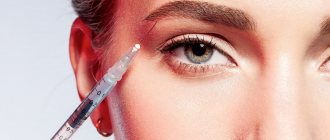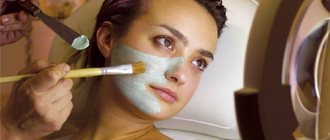Ovaries do not work: symptoms, causes, treatment
If the functioning of the reproductive organs is disrupted, then a woman cannot conceive and bear a child. To normalize reproductive function, you need to undergo treatment and find out the true reason why the ovaries do not work.
How does the malfunction of the appendages manifest itself?
Lazy ovaries cause a lot of problems. Patients suffering from infertility often have hormonal imbalances, which cause cycle disruptions.
Signs of normal functioning of the reproductive system:
- duration of menstruation from 4 to 10 days,
- interval between cycles 21-35 days,
- total blood loss during one menstruation is no more than 150 ml.
Ovarian dysfunction is often caused by hormonal problems and is manifested by a lack of ovulation and, as a consequence, infertility. A woman experiences irregular periods and bleeding between cycles. Menstrual flow is scanty.
Reasons why ovarian function is disrupted in women
Improper functioning of the appendages is noted as a result of:
- hormonal abnormalities, including PCOS,
- inflammatory processes,
- the presence of cystic formations, polyps, endometriosis,
- the use of certain medications,
- underweight
- diabetes, obesity (diseases provoke hormonal imbalance, which is reflected in the functioning of the ovaries),
- negative factors: changes in climatic zones, exposure to radiation, etc.,
- miscarriage or abortion,
- improper insertion of the intrauterine device.
Symptoms that the ovaries are not working well
The main cause of dysfunction of paired organs is a disruption in the production of sex hormones, provoked by deviations in the functioning of the hypothalamic-pituitary system. In this case, anovulation and luteal phase deficiency are observed, caused by excessive amounts of estrogen and progesterone deficiency.
Signs that the ovaries are not working include:
- irregular, scanty or heavy menstruation,
- bleeding between cycles
- miscarriage,
- infertility,
- dull and cramping pain in the lower abdomen, lower back (before menstruation, during it and during ovulation),
- pronounced PMS, accompanied by emotional problems,
- the interval between menstruation is less than 21 or more than 35 days, blood loss per cycle is more than 150 ml, bleeding lasting from 7 days,
- amenorrhea.
Diagnosis of pathology
To identify a malfunction of the ovaries, you need to contact a gynecologist. If he suspects hormonal causes of deviations, he will definitely refer you to a gynecologist-endocrinologist.
Diagnostic measures include:
- examination on a gynecological chair,
- anamnesis collection,
- exclusion of chronic reproductive diseases,
- Ultrasound of the pelvic region, thyroid and adrenal glands,
- examination of a vaginal smear for microflora,
- test for sexually transmitted diseases,
- determination of the concentration of sex hormones,
- radiography of the skull, CT and MRI of the brain,
- EEG to detect abnormalities
- hysteroscopy with cervical biopsy,
- curettage of the canal and cavity of the reproductive organ for histological examination of endometrial tissue.
Treatment of lazy ovaries
If there is no menstruation, then a detailed diagnosis is carried out, after which treatment is carried out. Therapy should be aimed at eliminating the root cause of deviations and combating concomitant diseases (diabetes mellitus, cystic formations, tumors, etc.). Additionally, vitamin and mineral complexes, massage, and physiotherapeutic procedures are prescribed.
If a woman suffers from obesity, then she is recommended to follow a diet and change her usual lifestyle. If you are underweight, measures are taken to normalize your weight. This allows you to restore ovulation and normal characteristics of the menstrual cycle. Then, when dysfunction of the appendages is caused by hormonal imbalance, a more serious approach is required.
So, with PCOS, if the patient does not plan a pregnancy, oral contraceptives are prescribed to even out the menstrual cycle and eliminate the symptoms of hormonal imbalance. For amenorrhea, the use of Duphaston is recommended. After a course of the drug, withdrawal bleeding begins, which is regarded as another period.
If PCOS is accompanied by an increase in blood sugar, then Metformin is used. With this treatment, hormonal levels are normalized, which allows the woman to conceive a child. At the discretion of the gynecologist, hormonal stimulation of ovulation or surgical intervention (laparoscopy) is performed.
The functioning of the ovaries is impaired for various reasons and can occur even against the background of intense and prolonged stress. Sometimes, to normalize the functioning of the reproductive system, it is enough to eliminate negative factors. Loading…
Source: https://kazandoctor.ru/ginekologiya/zabolevaniya/narushenie-raboty-yaichnikov-u-zhenshhin
Drug treatment
The tumor may gradually increase in size, but if it does not develop into a malignant formation and does not interfere with the normal functioning of internal organs, it can be eliminated using conservative therapy. After identifying the symptoms of ovarian cysts in women, treatment and prevention will be as follows.
If a papillary mucinous or serous cyst is detected in a woman of retirement age, surgery is indicated, since without proper treatment, ovarian cancer can develop. The use of certain medications makes it possible to reduce the formation in size and smooth out the symptoms as much as possible.
Typically, a doctor prescribes the following medications for the treatment of ovarian cysts in women over 50 years of age:
- Progestins or gestagens (Norkolut, Duphaston).
- Estrogen-containing drugs (“Marvelon”, “Ovidon”).
- Antiestrogens (Tamoxifen).
- Drugs to stimulate the immune system (Cycloferon, Timarin).
- Ascorbic acid.
- Anti-inflammatory suppositories with indomethacin.
- Analgesics (Baralgin).
- Homeopathic remedies that can improve hormonal levels (“Lycopodium”, “Bromium”, “Kalium”, “Apis”), especially if the patient’s ovarian tumor proceeds without any particular difficulties.
Lazy ovaries
Ovarian hypofunction is a group of pathological conditions that are manifested by weakened functionality of these organs. You need to understand that hypofunction is not a clinical diagnosis, but the result of the progression of various pathologies both in the ovaries and in the organs that control their function.
Functions
The ovaries are paired female sex glands and perform the following functions:
- Generative. It consists of ensuring the maturation of female germ cells, that is, maintaining the ability to conceive.
- Vegetative. It consists in the formation of the female phenotype, that is, in ensuring the correct development of secondary characteristics of the female sex.
- Hormonal. It consists of the cyclic production of progesterone and estrogen under the control of the hypothalamic-pituitary system.
In the body of a healthy woman of reproductive age, an egg matures monthly. During this process, the egg is located in the follicle.
The maturing follicle has a stimulating effect on estrogen production.
The complete development of the egg in the first phase of the cycle is ensured by FSH - follicle-stimulating hormone, which is produced in the pituitary gland.
During the ovulatory period, a mature egg is released from the follicle, and the corpus luteum is formed in its place.
From this moment, within two weeks, it produces progesterone, which is necessary for the correct course of pregnancy if conception occurs. If fertilization of the egg does not occur, then the destruction of the corpus luteum occurs.
In the next cycle it is formed again. The second half of the cycle is under the control of LH - luteinizing hormone.
Simultaneously with the cyclic processes in the ovaries, the endometrium grows in the uterus in the first phase of the cycle, and is rejected in the second. With hormonal imbalances, pathological changes also affect the endometrium. Therefore, for any symptoms of dysfunction in the reproductive system, its health is assessed comprehensively.
The nature of the menstrual cycle is a criterion for assessing the correct functioning of the ovaries. The presence of ovulation and a two-phase cycle indicate the proper functioning of these organs.
Causes
Hypofunctionality of the ovaries can accompany many diseases of the reproductive system, associated both with changes in the tissue of these organs itself, and with disorders in the central part of the endocrine system. Hypofunction can be primary or secondary.
Primary hypofunction is associated with disturbances in the processes of intrauterine development of the female body. Congenital underdevelopment of the ovaries may be a consequence of the mother's history of measles or rubella. It is also possible due to hormonal imbalance in the mother’s body, due to hereditary diseases in the expectant mother and due to psycho-emotional disorders she has suffered.
Secondary hypofunction can be triggered by factors listed below:
- A sharp decrease in body weight as a result of the progression of somatic pathologies or due to anorexia nervosa.
- Poor nutrition, which does not contain enough vitamins and fats.
- Infectious and inflammatory diseases of the ovaries (oophoritis, adnexitis).
- Pathologies of the pituitary gland and/or hypothalamus, provoked by traumatic brain injury, psycho-emotional disorders, and cancer of the brain.
- Diseases of the endocrine system affecting the thyroid gland and adrenal glands.
- Oncopathologies and polycystic ovary syndrome.
- Ovarian wasting syndrome.
- Uncontrolled long-term use of oral contraceptives.
Thus, ovarian hypofunction is a polyetiological condition, therefore, when it is identified, a comprehensive diagnosis is required to determine the exact cause and the appropriate method of correction.
Symptoms
Clinically, hypofunction is manifested by a disrupted menstrual cycle, reverse development of secondary sex characteristics, as well as infertility. In the case of primary hypofunction, the organs of the reproductive system remain underdeveloped. It is worth noting that the decrease in ovarian function during menopause is physiological.
The basis of the pathogenesis of hypofunction is hypoestrogenism - reduced production of estrogen. The clinical consequences of this condition are presented in the table.
The nature of clinical symptoms depends on the degree of hypofunction:
- Easy. The size of the uterus is normal or slightly reduced, the endometrium is formed correctly, but is not developed enough. Satisfactory development of secondary sexual characteristics. Irregular (less often than acceptable) and scanty menstrual bleeding, in some cases - amenorrhea.
- Average. Amenorrhea, underdevelopment of the external genitalia and mammary glands. The size of the ovaries and uterus is significantly smaller than the age norm.
- Heavy. It is quite rare. It is characterized by underdevelopment of the genital organs, the absence of secondary characteristics of sex, and primary amenorrhea.
Hypofunctional states that developed after the normal course of puberty are characterized by mild clinical symptoms. Hypofunction in this case manifests itself as cycle disorders: menstrual bleeding becomes short and scanty, and the interval between them gradually increases.
Without therapeutic correction, atrophic changes in the endometrium, amenorrhea, a decrease in the size of the ovaries and uterus develop, and psychoemotional disorders are also observed.
Diagnostics
Examination of a patient with manifestations of ovarian hypofunction should include:
- examination (assessment of physique, determination of the development of the genital organs and secondary sexual characteristics and the compliance of these parameters with age standards);
- ultrasound examination of the pelvic organs;
- laboratory studies of hormonal status.
Some additional diagnostic procedures may also be required depending on the characteristics of the clinical case. Only after identifying the provoking pathology and the degree of its severity can the doctor prescribe a course of therapeutic correction.
Treatment
What to do if the ovaries do not work? The answer to this question can be given by a specialist after a complete examination of the patient. Timely identified secondary hypofunction responds well to treatment, but with the primary nature of this condition, a full restoration of the functional state of the ovaries is unlikely.
Therapy of hypofunctional conditions is a complex, lengthy and multi-stage process. The first stage is to stimulate puberty in the case of pre-pubertal ovarian hypofunction. It involves the administration of estrogens in a cyclical manner to ensure that developmental processes are similar to natural ones.
At the same time, attention is paid to eliminating negative factors: infectious pathologies, stress, somatic diseases and others. The duration of the first stage is determined by the doctor.
If, in response to these measures, the uterus increases in size and signs of normal ovarian activity are recorded, then the second stage of therapy is carried out. It is needed in order to form cyclic changes in the ovaries.
The patient is prescribed hormonal medications according to the phases of the cycle. With their help, the menstrual cycle is reliably simulated so that the “lazy” ovaries begin to work.
Progesterone-containing drugs are added to estrogen-containing drugs.
The effectiveness of treatment must be monitored using ultrasound and laboratory diagnostic methods. The criterion that the treatment is effective is the identification of follicles at the stage of maturation and the recording of cyclic changes in the endometrium.
The goal of the third stage is to achieve an ovulatory two-phase cycle. The success of therapeutic measures depends on the severity of hypofunction. The fourth stage consists of rehabilitation measures and prevention of relapses of the hypofunctional state. It involves regular visits to the doctor and monitoring of the hormonal function of the ovaries.
Source: https://dou99.ru/yaichniki/lenivye-yaichniki
Premature ovarian failure (ovarian wasting syndrome): what to do?
Larisa Andreevna Marchenko, Doctor of Medicine, Professor, Leading Researcher of the Federal State Budgetary Institution "National Medical Research Center for Obstetrics, Gynecology and Perinatology named after Academician V. I. Kulakov."
Here you can get acquainted with the opinion of Professor L.A. Marchenko, presented at the XII International Congress on Reproductive Medicine in Moscow.
In the modern world, women often postpone having a child “until better times.” First you need to make a career, earn money, buy an apartment. There are many examples when a woman gives birth to her first child after 40 years. But sometimes it happens that by this age a natural pregnancy can no longer occur. This happens due to premature ovarian failure.
Why is this happening?
Premature ovarian failure syndrome occurs on average in no more than 3% of women. Even before birth, a girl has a certain number (about 400 thousand) of primordial follicles in her body.
Before the onset of puberty, they quietly “sleep”, biding their time. During puberty, a woman begins to gradually enter reproductive age, and her hormonal levels change. The level of luteinizing hormone (LH) and follicle-stimulating hormone (FSH) increases.
Under their influence, primordial follicles (from 5 to 15 vesicles per menstrual cycle), located inside the ovary, begin to grow. One of them, having reached maturity, releases an egg. Ovulation occurs and the woman gets her chance to get pregnant.
This story repeats itself every month for 35–37 years. This is the average reproductive age.
When functioning, the follicular apparatus of the ovary produces female sex hormones - estrogens. They are responsible for female sexual characteristics. After ovulation, the membrane of the vesicle turns into the corpus luteum and synthesizes progesterone, the pregnancy hormone.
Since the number of follicles is limited, sooner or later they run out. And then the climax comes. Sometimes this happens earlier than we would like. It is difficult to name the exact causes of this pathology. This is often due to heredity.
Other factors may also influence:
- diseases,
- operations,
- injuries,
- poisoning,
- exposure to strong drugs.
Ovarian exhaustion: how does it happen?
Manifestations of menopause, including early menopause, are very unpleasant. First of all, this is expressed in menstrual irregularities. Since declining ovaries noticeably reduce estrogen production, changes in hormonal levels affect overall well-being and appearance. The psycho-emotional state changes.
A woman may become irritable, nervous, tearful, prone to anxiety and depression. Outbursts of anger may occur. In some cases, diseases associated with metabolic disorders develop. Age-related changes begin to appear more clearly. The skin becomes less elastic, hair and nails become dull and brittle. Itching and dryness appear in the vagina.
Well-known signs of menopause are hot flashes and sweating.
Diagnosis of this condition usually includes:
- hormonal blood test (levels of FSH and LH, estrogen and progesterone, prostaglandin E2),
- Ultrasound (uterus, endometrium, ovaries)
- laparoscopic intervention (gonadal biopsy).
Expert opinion:
To detect premature ovarian failure early, the 2020 UK clinical guidelines say that attention should be paid to reducing Anti-Mullerian hormone (AMH) levels.
Research has shown that it drops about four years before follicle-stimulating hormone (FSH) levels rise. This means that by paying attention to AMH, we have the opportunity to detect incomplete pathology.
After all, in young women it often happens that FSH levels remain at normal levels, but AMH already shows low levels.
Ovarian wasting syndrome: treatment
Treatment usually involves taking a drug (containing estrogen and progesterone) to help maintain normal hormonal levels.
However, to answer the question of a patient with ovarian depletion, “How to treat this disease?” The doctor will not be able to immediately - choosing the right drug is possible only after laboratory blood tests.
Such treatment will normalize well-being and reduce the adverse manifestations of early menopause. However, the most serious problem that may bother women with this disease is the inability to become pregnant.
Unfortunately, the decline of ovarian function makes natural conception impossible. But this does not mean that you have to give up pregnancy. Modern methods make it possible to carry out the IVF procedure using a donor egg.
What is ovarian failure syndrome and how is it treated?
Dysfunction of hormone-producing organs, complicated heredity, infectious diseases and surgery are recognized as the main causes of early menopause, a clear manifestation of which is ovarian depletion. Treatment of this pathology is based on the use of synthetic hormones, phytocomplexes and physiotherapy aimed at restoring fertility and eliminating the unpleasant symptoms of menopause.
Factors that provoke ovarian depletion
Exhausted ovarian syndrome is diagnosed in 2% of women of late reproductive age (35-45 years), in whose bodies the maturation of follicles and the synthesis of sex hormones stops.
The development of a pathological process in young women is also possible.
Even at the time of intrauterine development, a certain number of primordial follicles are formed in the female body, which are activated only during puberty under the influence of hypothalamic hormones.
With each menstrual cycle, the follicular reserve gradually decreases. Complete loss of ovarian function, as a rule, occurs after 50 years and indicates a woman’s further inability to reproduce.
This is menopause - a natural physiological process that cannot be avoided. However, there are situations when depletion of the follicular apparatus occurs ahead of schedule: the ovaries stop synthesizing their own hormones.
Depletion of the follicular reserve is most often caused by a genetic factor, the so-called 3-chromosome syndrome, which appears under the influence of gene mutations in the prenatal period of embryo development. The abnormal structure of the ovaries leads to their premature aging.
An equally popular theory for premature decline in ovarian reserve is hormonal dysfunction. Increased production of gonadotropins triggers a mechanism of damage to the reproductive system, when autoimmune antibodies destroy the ovarian tissue's own tissue, reducing the supply of full-fledged follicles.
The decline of ovarian function earlier than the age norm can also be caused by other reasons:
- infectious diseases;
- chronic diseases of the endocrine, nervous, excretory systems;
- surgical intervention in the reproductive organs (resection of the ovaries, removal of cysts, tumors);
- intoxication of the body with drugs and toxic substances;
- diseases suffered by a woman during pregnancy;
- stressful situations;
- high physical and mental stress;
- strict diets, fasting;
- disruption of metabolic processes in the body;
- autoimmune diseases;
- negative impact of ionizing radiation.
When is treatment needed?
Ovarian wasting syndrome has characteristic symptoms: external age-related changes and an abnormal structure of the paired organ, diagnosed during its examination.
The following signs may indicate lazy (depleted) ovaries:
- lack of ovulation despite regular sex life without the use of contraceptives;
- hot flashes;
- increased sweating;
- dizziness, headaches;
- cardiopalmus;
- blood pressure surges;
- swelling of the limbs;
- darkening of the eyes when changing body position;
- thyroid dysfunction;
- decreased physical activity;
- memory impairment;
- hair loss, thinning of hair;
- changes in the structure of skin, hair, nails;
- the appearance of wrinkles on the face and neck;
- hyperpigmentation of certain areas of the skin;
- psycho-emotional instability;
- male pattern fat deposition;
- underdevelopment of secondary sexual characteristics;
- frequent, unproductive urination;
- vaginal dryness;
- decreased sex drive;
- the occurrence of cardiovascular diseases.
A laboratory blood test indicates ovarian depletion:
- low levels of estrogen, progesterone, estradiol, prolactin, prostaglandins;
- high concentration of follicle-stimulating and luteinizing hormones, triglycerides.
Signs of ovarian depletion (aging) can also be confirmed using instrumental diagnostics:
- Electroencephalography determines brain activity, reveals dysfunction of the hypothalamus, and the presence of diseases of the central nervous system that affect the functioning of the ovaries.
- Using metrosalpingography, you can detect a decrease in the size of the uterine body, narrowing of its cervix, and thinning of the endometrium.
- Ultrasound examination of the pelvic organs determines the reduction of the ovaries, underdevelopment of the follicular reserve, the absence of maturing follicles, and the presence of any neoplasms.
- Laparoscopy of the ovaries followed by a biopsy is aimed at examining the connective tissue, outer layer, and structure of the organ. As a result of a cytological examination, the replacement of ovarian tissue with connective tissue and the absence of full-fledged follicles are confirmed.
Depleted ovaries and pregnancy
Is it possible to get pregnant with depleted ovaries? There is a chance for successful conception provided that timely treatment with hormonal drugs is provided. Exhausted ovarian syndrome is not a death sentence at all. Pregnancy occurs in 60% of cases if the provoking factor is eliminated.
However, it is necessary to remember that against the background of depleted ovaries, the risk of gestational diabetes, hypertension, preeclampsia, and weight gain increases.
The presence of this pathology also affects the intrauterine development of the fetus, provokes miscarriage, and premature onset of labor.
The goal of hormone therapy is to stimulate ovulation:
- First of all, the attending physician prescribes antiestrogenic drugs that help restore the natural menstrual cycle.
- For infertility of progesterone origin and habitual miscarriage, Duphaston is used for 3-6 months. For amenorrhea, Duphaston is used in combination with estrogens from the 11th to the 25th day of the menstrual cycle for 3 months. The same treatment regimen is followed for the short luteal phase.
- In the absence of a positive result of treatment, follicle-stimulating hormone drugs (Metrodin, Urofollitropin) are indicated to achieve “superovulation”. The drug is taken for 2 or more menstrual cycles in consultation with the attending physician. To stimulate the growth of multiple follicles, the doctor may prescribe assisted reproductive techniques.
If, as a result of conservative treatment, pregnancy does not occur, surgical intervention using laparoscopy is resorted to. Wedge resection of the ovaries involves removing 2/3 of the organ. Medical statistics confirm the effectiveness of such treatment in most cases.
Hormonal therapy carried out in pregnant women involves the use of drugs that cause normal secretory transformations in the endometrium, contributing to the successful gestation of the fetus. From 11 to 25 days of the menstrual cycle, Duphaston is prescribed, adjusting the dose after colpocytological examination.
Hormonal therapy is contraindicated during the lactation period, as it passes into breast milk. Breastfeeding is stopped during treatment.
Traditional medicine
Traditional methods of treatment are included in complex therapy, but do not replace the classical treatment regimen for ovarian dysfunction.
- Exhausted ovarian syndrome is treated with sedatives and infusions. A positive effect on the nervous system was noted from infusions of peppermint (1 tablespoon of dry raw materials per 0.5 liters of water), viburnum, cranberry and blackberry fruit drinks.
- Eliminates psycho-emotional instability freshly squeezed beet juice (100 ml), to which 1 tbsp is added. l. honey The medicine is taken 2 times a day, 50 ml.
- Treatment with folk remedies includes the use of egg-lemon suspension, which effectively combats the manifestations of early menopause due to its high lecithin content. To prepare it, you need to grind lemons and eggshells using a blender in a 1:1 ratio. The resulting mixture is infused for 3-4 weeks, and then consumed 3 times a day, 1 tbsp. spoon.
- You can eliminate the symptoms of ovarian depletion with the help of an infusion of boron uterus. Brew 1 tbsp in 250 ml of water. spoon of dry herb and leave for 30-40 minutes. The infusion is taken up to 5 times a day, 1 tbsp. spoon before eating.
- Infusions of wintergreen, one-sided ortilia, red brush, and field grass, which are prepared in a similar way, have similar properties.
- When the ovaries are depleted, the daily diet must include foods containing lecithin, folic acid, natural phytoestrogens, and B vitamins. These include sprouted grains of wheat, rye, soy, lentils, beans, cauliflower, nuts, fish, egg yolks and others.
- To prepare herbal tea with phytoestrogenic properties, clover, alfalfa, viburnum, sage, ginger, and Abraham tree are used. 0.5 tsp. dry raw materials are brewed in 250 ml of water and left for 15-20 minutes. Take 2-3 times a day for two to three weeks.
Traditional medicine is used only after consultation with the attending physician. Any plant is a potential allergen and, if the body is sensitive, can produce the opposite effect.
Timely identification of the true cause of early depletion of follicular reserves and an integrated approach to treatment prevent loss of fertility and unpleasant symptoms of early menopause.
Source: https://DrLady.ru/disease/chto-takoe-sindrom-istoshhennyh-jaichnikov-i-kak.html
Features of the ovaries during menopause
As age increases, the number of follicles in the ovarian cavity gradually decreases, which provokes a decrease in the amount of sex hormones produced by this organ. A decrease in estrogen synthesis is the trigger in the development of pathological manifestations of menopause, because most of the processes occurring inside the female body are hormone-dependent.
The lack of estrogen causes a response from the hypothalamus, the essence of which is that it tries to restore the full functioning of the ovaries by sending follicle-stimulating hormone to help. Changes in the functioning of the hypothalamus provoke the development of malfunctions in the thermoregulation system, which explains the nature of hot flashes.
Lack of estrogen affects the nervous, endocrine, cardiovascular, excretory, digestive, and genitourinary systems of the body, causing irreversible changes in them. Hormone deficiency affects both the condition of the musculoskeletal system and the appearance of a woman.
As menopause progresses, ovarian activity steadily declines. By the time of the full onset of menopause, the process of egg maturation finally stops, ovulation no longer occurs, which is expressed by such an external sign as the cessation of menstrual bleeding.
Postmenopause is characterized by a complete cessation of estrogen synthesis by a woman’s ovaries. However, it would be incorrect to say that the production of this female hormone completely stops in a woman’s body during the postmenopausal period. The human body itself is endowed by nature with high adaptive abilities, therefore the reproduction of estrogens continues outside the gland - they are synthesized by peripheral structures (adrenal glands, adipose tissue).










